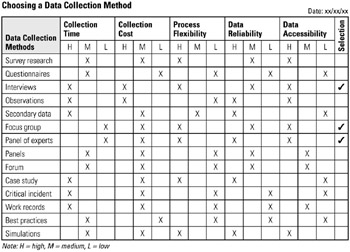Tool 177: Selection Matrix
| AKA | Selection Grid |
| Classification | Evaluating/Selecting (ES) |
Tool description
A selection matrix helps a researcher to identify the appropriate tool, method, or procedure for a specific task. Once a team has developed the criteria to be used for deciding on a selection, the matrix is examined and the item that best fits the criteria is chosen.
Typical application
-
To select an appropriate tool, methodology, or procedure needed to perform a task.
-
To facilitate the decision process by matching established criteria to choices under consideration.
-
To compare all available alternatives.
Problem-solving phase
| Select and define problem or opportunity | |
| → | Identify and analyze causes or potential change |
| Develop and plan possible solutions or change | |
| Implement and evaluate solution or change | |
| → | Measure and report solution or change results |
| Recognize and reward team efforts |
Typically used by
| 1 | Research/statistics |
| Creativity/innovation | |
| Engineering | |
| 3 | Project management |
| Manufacturing | |
| 4 | Marketing/sales |
| Administration/documentation | |
| Servicing/support | |
| Customer/quality metrics | |
| 2 | Change management |
before
-
Data Selection Strategy
-
Sampling Methods
-
Random Numbers Generator
-
Information Needs Analysis
-
Demographic Analysis
after
-
Response Data Encoding Form
-
Decision Tree Diagram
-
Process Analysis
-
Cluster Analysis
-
Case Study
Notes and key points
-
The high, medium, low rating assigned in the example may vary with different processes used to collect the data needed.
Step-by-step procedure
-
STEP 1 The team facilitator leads a discussion on the process for establishing a set of criteria to be used for deciding on a tool, method, or procedure.
-
STEP 2 A previously recorded list of iteams is copied onto a selection matrix form. See example Choosing a Data Collection Method.
-
STEP 3 Participants rate all items using the established criteria. The items that best match the requirements are selected as shown in the example. In our example, process flexibility and data accessibility were the primary considerations.
-
STEP 4 The facilitator dates the matrix and assigns necessary next step action items.
Example of tool application

EAN: 2147483647
Pages: 326